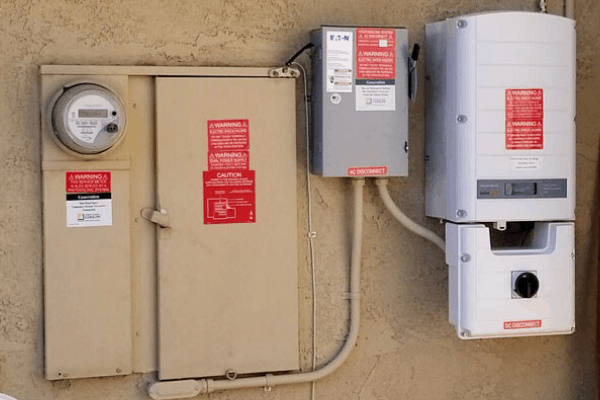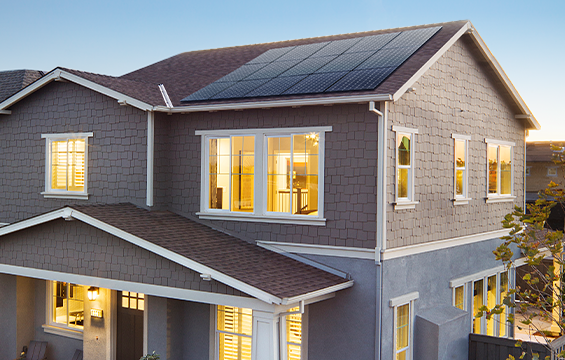What Will The Solar Layout Look Like On My Roof?
Your home will determine your solar design. Solar power at its best is not a cookie-cutter project. The more customized it is to your home and your family’s power usage, the better the solar ROI will be. Several factors affect your system’s solar design.
Elements Affecting of Your Solar Design

When designing a solar power system for your home, know that the solar design is affected by the following elements:
- The Roof And Its Condition
- The Electrical Service Panel
- Your Power Usage and Utility Company
- HOA & City Regulations
Importance Of The Roof
The roof is the most critical factor for solar power to work well for you unless you have the property for a ground mount. The most basic consideration is the condition of your roof and what type of roof it is. The solar will be on your roof for a long time. It must be in good condition without leaks, worn-out shingles or broken tiles, worn-out underlayment, or rotted wood.
The Best Time to Re-Roof is Now
Your solar contractor should give your roof a thorough inspection during the initial site evaluation. No one wants any surprises on the day of installation. If you need to reroof to go solar, then the roof may qualify for the solar tax credit. It’s a good idea to get needed roof work and solar at the same time because of the tax credit. Ask your contractor for photos of your roof that are taken during the site survey.

Comp Shingle vs. Tile Roofs
Composition shingle roofs are typically the easiest for solar to be mounted on. If you have tile, it will depend on the type of tile you have. There’s a lightweight tile that shatters easily when walked on. Many solar contractors will require shingles installed in the solar area (inset), or have you pay to replace the broken tile.
If your home has clay tile, you will need to have composition shingles laid in the solar area, which is an inset. Wood shake roofs can’t have solar mounted on them in most cities. Flat roofs may need to have a tilt package installed to angle the panels up. Specialty roofs can be done, but they cost a bit more.
What about a Ground Mount?

Homeowners with land often choose a ground-mounted system. They cost more due to trenching and special racking plus cement piers. They gain more control over their solar design, however, as they aren’t limited by their roof. Because of that, their systems can be optimized to produce more. The main reason for increased production is they can point it south at the sun.
Permits take longer in most jurisdictions for ground mounts, and the installations take longer. Multiple inspections are required. Another popular option is putting panels on a patio or carport. Building a structure like a carport just for the solar extends the time to recoup the investment.
Orientation (Azimuth)

The direction that solar panels face determines how much power they will produce. To a lesser degree, the degree of tilt to your roof also affects solar production. South-facing panels produce the most power and north-facing arrays produce the least. East and West roofs produce less than South. However, with Time of Use rates, there is a benefit to west roofs as they offset peak afternoon rates.
Tilt
Most roofs in California have a 20-degree pitch or close to it, which is ideal. Extremely steep roofs will produce less power; panels on flat roofs are usually tilted up at 10-15 degrees to catch more sun. If you have a very steep roof (30-degree pitch or more), many solar companies will charge extra for the installation. Flat roofs are most at risk for leaking; if you have one, be sure to hire a solar company that has experience with roofing.
Roof Size Matters
One of the most important factors is the size of your roof, or better put, the area available for solar. Chimneys, vents, AC units, and fire code setbacks limit how many panels can be mounted on it. Some people don’t want panels on the front of their homes yet that might be the best area for solar. For limited roof space, solar panel efficiency matters the most.
Shading Ruins Solar Production

Shading is the enemy of solar. It can be caused by trees, chimneys, vents, dormers, roof-mounted fans, and AC units among other things. Shade moves during the day and also changes over the seasons. Get to know the shading on your roof because it’s one of the most common problems of solar, reducing production. Not every contractor is diligent about shading studies. A small vent casting a shadow can take out 10% or more of a panel’s production. Keep this in mind when looking at rooftop layouts.
Your monitoring system will present clear evidence of shading. You may think a panel is not performing properly when its production is outpaced by the other solar panels. Shading may not be evident all day long, and there only has to be brief shading to affect performance dramatically.
Your Main Service Panel: Is It Good For Going Solar?

Your solar connects to your electrical main service panel in most cases. A 200 amp service can support most solar systems, while 100 amp service usually can’t. Some panels are filled to the max, and a subpanel will be needed. Your contractor may suggest upgrading your service panel, derating it, or using a meter adapter provided by your utility company. Only in rare cases does the electrical service create an issue for installing solar. An example would be when there’s a high cost of upgrading such as required trenching. Typically, a standard service upgrade costs around $2500. The best time to upgrade old and outdated electrical panels is when you go solar since you get the tax credit. Your upgrade should be performed by a C-10, so verify the license of the contractor.
Annual Power Usage

It’s important to have 12 months of usage to properly design your solar. If the past 12 months varied from your typical usage, then go back 2-3 years and get the average. You want to size your solar to offset 110-120% of your electricity usage. If you plan to buy an electric vehicle or add other loads, plan on increasing the size more. If you foresee a drop in usage, size the system down accordingly. Getting the right size is important to make a wise investment.
How to Get My Usage
The best way to get your last 12 months’ usage is directly from your utility company. If you keep paper bills, great. If not, call them and ask for your last 12 months of usage. Write it down, month by month. Add up the 12 months, and this is your annual usage. Multiply that by 120%; this would be the size you should aim for unless you plan to increase your power usage. You should aim for at least 110% of your annual usage. If you have municipal power, then you must not exceed 100% in most cities.
Will It Offset My Bill?
Every solar sales proposal should show the total kilowatt-hours a system will produce. The accuracy of the proposed production of energy is dependent on the quality of the input. While solar salespeople are trained to create proposals, many don’t know how to create an accurate one. They may not account for shading or put more panels on the favorable roofs than can fit there. Get proposals from a few companies so you can compare the layouts and production.

What Affects My Solar Layout?
Solar design is affected by solar fundamentals plus fire code and HOA limitations, if applicable. Fire setbacks are pathways that firemen use to access the home via the roof, and usually are 3 feet from the ridge and other edges of the roof. Requirements vary by city and HOA. Your solar sales proposals should reflect these setbacks, and not fill your entire roof plane. There are a few exceptions, such as covering the roof of a free-standing garage or shop.
Your Home on Satellite Imagery
Take a look at your home on google maps satellite imagery. The roof planes that point South, East, or West are better choices than planes that face north. Does your roof have multifaceted planes, or is it just a few roof planes? Do you have tall trees or chimneys? The fewer arrays, the better, and the less shading, the better. Get to know your roof and its strengths and weaknesses. Panels in rectangles look the best aesthetically, but due to vents or other design constraints, they may not be achievable. City fire setbacks also affect how much solar can fit on your best roof planes.
High-Efficiency Solar Panels
When space is limited, opt for high-efficiency panels. Higher-efficiency panels produce more energy per square inch. A panel’s efficiency should be the primary consideration when your home has limited roof space or you’d like a smaller solar footprint. Currently, Sunpower has the highest efficiency panels on the market.
SunPower has the most elegant complete-system design called the Equinox system. With a low profile look and invisible racking, it will not detract from your home’s curb appeal. Read our review of the Sunpower Equinox System.
When we link to a product or website that we are affiliated with, we may be paid a commission based on the sale of such products.

Solar Conduit Is An Important Factor For Design

One of the differentiating factors of a quality installation is how the conduit is run. The highest quality installers offer to run the conduit through the attic when an attic is available. This is called an attic run and may cost extra. When the conduit is run on the exterior, it should be minimally visible. Many HOA’s require black rails and for the arrays to be low profile. This is why you should drive by installations and review pictures of contractors’ work. Sloppy conduit runs are easily spotted. It’s your home, be sure it’s not ruined by a sloppy installation. Start noticing solar installs everywhere you go and you will get picky.
Be Home for Your Site Evaluation
Great installers perform excellent site evaluations after you sign the contract, and this will reveal possible roofing or electrical issues. Always make arrangements to be home during the survey, and don’t choose a company that does a remote or satellite image-based survey. A solid survey sets your project up for success, with no surprises at installation.
When it comes to picking the best solar company, be sure to read this in-depth guide!

